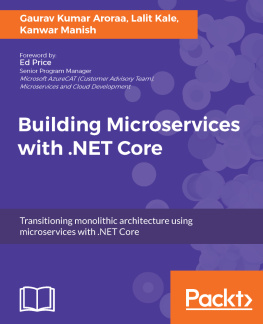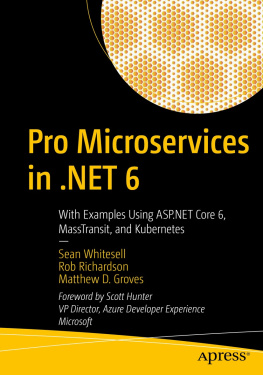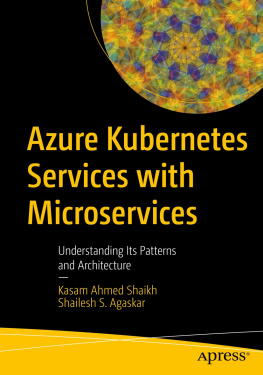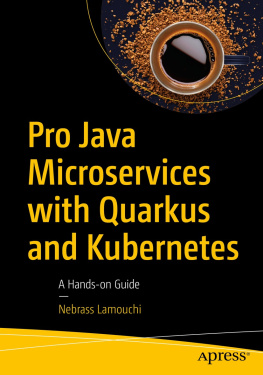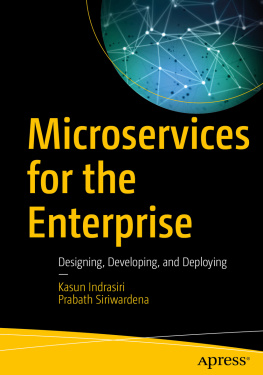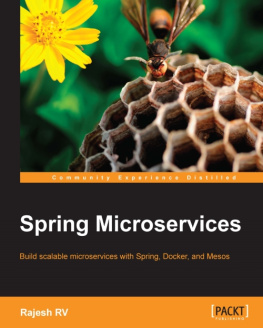Gaurav Kumar Aroraa - Building Microservices with .NET Core
Here you can read online Gaurav Kumar Aroraa - Building Microservices with .NET Core full text of the book (entire story) in english for free. Download pdf and epub, get meaning, cover and reviews about this ebook. year: 2017, publisher: Packt Publishing, genre: Home and family. Description of the work, (preface) as well as reviews are available. Best literature library LitArk.com created for fans of good reading and offers a wide selection of genres:
Romance novel
Science fiction
Adventure
Detective
Science
History
Home and family
Prose
Art
Politics
Computer
Non-fiction
Religion
Business
Children
Humor
Choose a favorite category and find really read worthwhile books. Enjoy immersion in the world of imagination, feel the emotions of the characters or learn something new for yourself, make an fascinating discovery.
- Book:Building Microservices with .NET Core
- Author:
- Publisher:Packt Publishing
- Genre:
- Year:2017
- Rating:5 / 5
- Favourites:Add to favourites
- Your mark:
Building Microservices with .NET Core: summary, description and annotation
We offer to read an annotation, description, summary or preface (depends on what the author of the book "Building Microservices with .NET Core" wrote himself). If you haven't found the necessary information about the book — write in the comments, we will try to find it.
Architect your .NET applications by breaking them into really small piecesmicroservicesusing this practical, example-based guide
About This Book
- Build, deploy, and test microservices using ASP.Net MVC, Web API, and Microsoft Azure Cloud
- Get started with reactive microservices and understand the fundamentals behind it
Who This Book Is For
This book is for .NET Core developers who want to learn and understand microservices architecture and implement it in their .NET Core applications. Its ideal for developers who are completely new to microservices or have just a theoretical understanding of this architectural approach and want to gain a practical perspective in order to better manage application complexity.
What You Will Learn
- Compare microservices with monolithic applications and SOA
- Identify the appropriate service boundaries by mapping them to the relevant bounded contexts
- Define the service interface and implement the APIs using ASP.NET Web API
- Integrate the services via synchronous and asynchronous mechanisms
- Implement microservices security using Azure Active Directory, OpenID Connect, and OAuth 2.0
- Understand the operations and scaling of microservices in .NET Core
- Understand the testing pyramid and implement consumer-driven contract using pact net core
- Understand what the key features of reactive microservices are and implement them using reactive extension
In Detail
Microservices is an architectural style that promotes the development of complex applications as a suite of small services based on business capabilities. This book will help you identify the appropriate service boundaries within the business. Well start by looking at what microservices are, and what the main characteristics are.
Moving forward, you will be introduced to real-life application scenarios, and after assessing the current issues, we will begin the journey of transforming this application by splitting it into a suite of microservices.
You will identify the service boundaries, split the application into multiple microservices, and define the service contracts. You will find out how to configure, deploy, and monitor microservices, and configure scaling to allow the application to quickly adapt to increased demand in the future.
With an introduction to the reactive microservices, you strategically gain further value to keep your code base simple, focusing on what is more important rather than the messy asynchronous calls.
Style and approach
This guide serves as a stepping stone that helps .NET Core developers in their microservices architecture. This book provides just enough theory to understand the concepts and apply the examples.
Gaurav Kumar Aroraa: author's other books
Who wrote Building Microservices with .NET Core? Find out the surname, the name of the author of the book and a list of all author's works by series.

